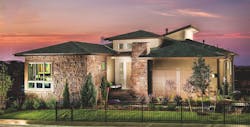Traditional Neighborhood Development: Past, Present, and Future
New Urbanism has been called the most influential planning movement of the last three decades. Since the first New Urbanist community, Seaside, opened in Fort Walton Beach, Fla., in 1980, hundreds of new towns, villages, and neighborhoods that embrace New Urbanist principles have been completed or are under construction in the United States.
There are also hundreds of smaller-scale projects in the works to restore downtowns and first-tier suburbs, says Chris Grady, senior land planner for Denver-based Kephart. And in new suburban development, “a hybrid approach combining conventional design and tenets of New Urbanism has increased in the last 20 years,” Grady says.
Form-based codes are being written to ease the implementation of new projects and to ensure a greater diversity of building and street types that are also contextually appropriate. And New Urbanism itself has evolved, giving rise to new platforms such as Lean Urbanism that cut red tape and provide ways for new and undercapitalized developers to do smaller infill projects.
“Builders are pulling forward things they perceive as adding a tremendous amount of value,” says architect Barry Long of Urban Design Associates, in Pittsburgh. “That, combined with specific market conditions, such as the need for better public transportation or a jobs/housing balance, is influencing community design. I think more conventional approaches are at a competitive disadvantage.”
The proof is in the profits. As Berkeley, Calif., developer Keith McCoy says, “We have learned that people will pay a premium—20 to 40 percent—to live in a well-planned and executed traditional neighborhood development (TND.)”
Early Developments Offer Valuable Lessons
The environmental practices implemented at Seaside were considered cutting edge back in the day: passive ventilation, permeable pavement, and native landscape preservation, to name a few. Kentlands, in Maryland, which celebrated its 25th anniversary last year, inspired the creation of HUD’s HOPE VI affordable-housing program.
Miami-based Duany Plater-Zyberk & Co. (DPZ), the designers of Seaside, Kentlands, and a host of other New Urbanist communities, has launched initiatives such as Lean Urbanism, and SmartCode. Whereas conventional codes are based on use, SmartCode is a form-based code that specifies the massing and orientation of buildings rather than the use. It was written using freeware that towns could download, says DPZ partner Andres Duany.
Eliza Juliano, director of urbanism for Canin Associates, in Orlando, Fla., sees a move away from “more boutique New Urbanist projects that are very high-end, with the focus on custom architecture.” Newer TNDs offer affordable-housing options that aren’t limited to apartments and townhouses. For example, Canin is designing high-density, single-family detached homes that can achieve a density of between eight and 13 units per acre.
The treatment of retail has also matured, says Peter Calthorpe, the Berkeley, Calif.-based architect, urban designer, and land planner behind Daybreak, Stapleton, and other well-known TNDs. Whereas early communities had retail “at every neighborhood center, every quarter mile, that’s not the way people shop and stores succeed,” Calthorpe says. “What used to be the corner shop has a hard time surviving, except in existing downtowns. In a newly built community, the healthiest retail clusters around a grocery store.”
Old and New Concepts in Traditional Neighborhood Development
NorthSky at RidgeGate, in Lone Tree, Colo., opened in June 2014. It’s a transition between the heart of RidgeGate and the adjacent open space and older nearby developments, says Scott Sudik of Godden|Sudik Architects, in Centennial, Colo. The builders are Berkeley Homes, of Aurora, Colo., and Denver-based Harvard Communities.
“NorthSky is on the outer fringe and not necessarily a prototypical TND-specific development,” Sudik says. Yet, like Seaside, the architecture is inspired by the region: a contemporary Colorado style with plans that embrace outdoor living and feature dramatic rooflines, stone elements, and earth-tone colors.
At 2,453 to 3,811 square feet, the NorthSky homes are larger than typical TND homes and have front-loaded garages. However, they also have generous front porches and a variety of garage configurations that minimize the impact of garage doors. The project’s scale is smaller and more typical of a TND, with just 33 lots measuring 60 by 105 feet.
Within six months of the grand opening, 28 homes had been sold at prices from $800,000 to the $1.1 million range. “I believe the success of NorthSky is somewhat related to the ideas in Lean Urbanism,” Sudik says. “Specifically, NorthSky is a small project that was able to be unique and special. There were no overbearing design guidelines that forced it to fit with a finite, predetermined template or style.”
The homes at NorthSky at RidgeGate, in Lone Tree, Colo., have a mid-century modern vibe that attracts boomers as well as Millennials. Godden|Sudik Architects took full advantage of the prairie and mountain views with 15-foot ceilings and strategically placed interior glass walls in nearly every room. Photo: Eric Lucero Photography
The Most Appealing Communities Evolve Over Time
New Urbanist communities are most likely to flourish when developers and designers get the public involved in the planning process. That takes more time, but consider that the best communities have shaped their character and authenticated their value over many years.
“TNDs such as Kentlands and Seaside didn’t happen overnight,” says UCP’s Keith McCoy. “[Their creators] figured out early on—almost out of necessity—that building incrementally and at a slower pace resulted in the ability to adapt and change along the way.”
Bainbridge Island, Wash., architect Jonathan Davis cautions against trying to develop a new town too quickly. “It can become a bit of a stage set,” he says. “Be careful of trying to create or replicate something of the past all at one time.”
Duany emphasizes the importance of architectural diversity. “If you downstream the architecture to others, it has that incredible variety, and you can learn and improve over time, which makes a real town,” he says. “Urbanism is more about time than scale. That’s the ingredient that makes it great.”
3 Traditional Neighborhood Development Case Studies
Bainbridge Island Community Builds Connections
Downtown Is the Biggest Amenity for this Texas Community
Correcting a Jobs/Housing Imbalance in Monterey, Calif.
Lean Urbanism: The Next Iteration
John Anderson used to develop large properties in Southern California, but after the recession killed a 200-acre project, he decided to change his business model. Anderson formed a partnership with designer David Kim and started pursuing Lean Urbanism, an initiative of New Urbanism that encourages smaller-scale, infill development.
“Out of raw necessity, we started looking at the smallest piece we could build on and make a profit,” says the principal of Anderson|Kim Architecture & Urban Design, in Chico, Calif. “What if we built units for rent, and not 150 units [at once] but a small portfolio that over time we would be able to manage efficiently?”
One recent success is Hutchinson Green Apartments, built on the last two parcels of a 20-acre TND called Doe Mill. There are 22 apartments in two- and three-story buildings, with 11 apartments on each parcel. “Our pro forma said each unit would rent for $950 a month,” Anderson says. “They actually rented for $1,100 a month—$1,300 for the third-floor units, which have a view.”
Hutchinson Green targeted the renter-by-choice market in Chico, a college town, and it leased up very quickly. Residents include hospital employees who work the night shift and don’t want to live in a building full of noisy college students. The apartments have one bedroom plus a study, which is ideal for singles as well as single parents who have shared custody of their children.
“I think we’re going to be seeing an entire new cohort of small developers and builders producing either apartments or small mixed-use or commercial buildings in more of an urban neighborhood context,” Anderson says. “They’ll be filling in a missing piece or looking to change the corridor of crap—the old strip malls and office parks.”
Hutchinson Green Apartments was built on the last two parcels in Doe Mill, a TND in Chico, Calif. Builder/developer John Anderson says that modest multifamily projects work well in locations suited for Lean Urbanism, particularly if there is food and drink within walking distance. Illustrations: Anderson|Kim Architecture & Urban Design
The Hutchinson Green building elevations were designed to fit seamlessly alongside existing rowhouses in the neighborhood.
About the Author

Susan Bady
Susan Bady has been writing about the housing industry for 30 years. She is senior editor of Professional Builder and Custom Builder magazines, and produces the Design Innovation e-newsletter. Bady has also written for such consumer magazines as Cabin Life and Better Homes and Gardens’ Home Plan Ideas.




